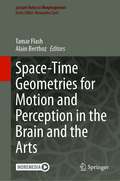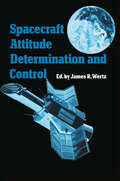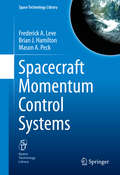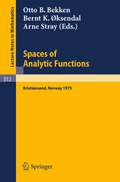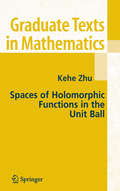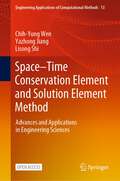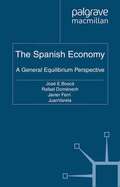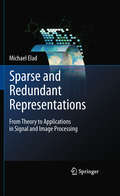- Table View
- List View
Space-time: An Introduction to Einstein's Theory of Gravity
by Jonathan AlldayRead an exlusive interview with Dr. Allday where he discusses the importance of the monumental first image of the black hole, here. This book, suitable for interested post-16 school pupils or undergraduates looking for a supplement to their course text, develops our modern view of space-time and its implications in the theories of gravity and cosmology. While aspects of this topic are inevitably abstract, the book seeks to ground thinking in observational and experimental evidence where possible. In addition, some of Einstein’s philosophical thoughts are explored and contrasted with our modern views. Written in an accessible yet rigorous style, Jonathan Allday, a highly accomplished writer, brings his trademark clarity and engagement to these fascinating subjects, which underpin so much of modern physics. Features: Restricted use of advanced mathematics, making the book suitable for post-16 students and undergraduates Contains discussions of key modern developments in quantum gravity, and the latest developments in the field, including results from the Laser Interferometer Gravitational-Wave Observatory (LIGO) Accompanied by appendices on the CRC Press website featuring detailed mathematical arguments for key derivations
Space-Time Algebra
by David HestenesThis small book started a profound revolution in the development of mathematical physics, one which has reached many working physicists already, and which stands poised to bring about far-reaching change in the future.At its heart is the use of Clifford algebra to unify otherwise disparate mathematical languages, particularly those of spinors, quaternions, tensors and differential forms. It provides a unified approach covering all these areas and thus leads to a very efficient ‘toolkit’ for use in physical problems including quantum mechanics, classical mechanics, electromagnetism and relativity (both special and general) – only one mathematical system needs to be learned and understood, and one can use it at levels which extend right through to current research topics in each of these areas. These same techniques, in the form of the ‘Geometric Algebra’, can be applied in many areas of engineering, robotics and computer science, with no changes necessary – it is the same underlying mathematics, and enables physicists to understand topics in engineering, and engineers to understand topics in physics (including aspects in frontier areas), in a way which no other single mathematical system could hope to make possible.There is another aspect to Geometric Algebra, which is less tangible, and goes beyond questions of mathematical power and range. This is the remarkable insight it gives to physical problems, and the way it constantly suggests new features of the physics itself, not just the mathematics. Examples of this are peppered throughout ‘Space-Time Algebra’, despite its short length, and some of them are effectively still research topics for the future.From the Foreward by Anthony Lasenby
Space, Time, and Mechanics: Basic Structures of a Physical Theory (Synthese Library #163)
by D. Mayr G. SüssmannIn connection with the "Philosophy of Science" research program conducted by the Deutsche Forschungsgemeinschaft a colloquium was held in Munich from 18th to 20th May 1919. This covered basic structures of physical theories, the main emphasis being on the interrelation of space, time and mechanics. The present volume contains contributions and the results of the discussions. The papers are given here in the same order of presentation as at the meeting. The development of these "basic structures of physical theories" involved diverging trends arising from different starting points in philosophy and physics. In order to obtain a clear comparison between these schools of thought, it was appropriate to concentrate discussion on geometry and chronology as the common foundation of classical and quantum mechanics. As a rather simple and "Tell prepared field of study, geochronometry seemed suited to analysing these mutually exclusive positions. vii D. Mayr and G. Sussmann (eds.), Space, Time, and Mechanics, vii. Copyright © 1983 by D. Reidel Publishing Company. ACKNOWLEDGEMENT The editors gratefully appreciate the sponsorship of the Deutsche Forschungsgemeinschaft and the cooperation of the authors and publisher. It is also a pleasure to thank Frau M.-L. Grohmann and Frau I. Thies for their organisational and especially Frau B. Grund for typing and clerical work. D. MAYR G. SUSSMANN 1982 University of Munich viii INTRODUCTION The distinct positions present at the symposium may be roughly divided into three schools that differ in their philosophical interpretation of physics and their meta- .. . ~ .
Space, Time, and Spacetime: Physical and Philosophical Implications of Minkowski's Unification of Space and Time (Fundamental Theories of Physics #167)
by Vesselin PetkovDedicated to the centennial anniversary of Minkowski's discovery of spacetime, this volume contains papers, most presented at the Third International Conference on the Nature and Ontology of Spacetime, that address some of the deepest questions in physics.
Space-Time Foliation in Quantum Gravity (Springer Theses)
by Yuki SatoIn this thesis, the author considers quantum gravity to investigate the mysterious origin of our universe and its mechanisms. He and his collaborators have greatly improved the analyticity of two models: causal dynamical triangulations (CDT) and n-DBI gravity, with the space-time foliation which is one common factor shared by these two separate models. In the first part, the analytic method of coupling matters to CDT in 2-dimensional toy models is proposed to uncover the underlying mechanisms of the universe and to remove ambiguities remaining in CDT. As a result, the wave function of the 2-dimensional universe where matters are coupled is derived. The behavior of the wave function reveals that the Hausdorff dimension can be changed when the matter is non-unitary. In the second part, the n-DBI gravity model is considered. The author mainly investigates two effects driven by the space-time foliation: the appearance of a new conserved charge in black holes and an extra scalar mode of the graviton. The former implies a breakdown of the black-hole uniqueness theorem while the latter does not show any pathological behavior.
Space-Time Geometries for Motion and Perception in the Brain and the Arts (Lecture Notes in Morphogenesis)
by Tamar Flash Alain BerthozThis book is based on a two-day symposium at the Paris Institute of Advanced Study titled "space-time geometries and movement in the brain and the arts". It includes over 20 chapters written by the leading scientists and artists who presented their related research studies at the symposium and includes six sections; the first three focus on space-time geometries in perception, action and memory while the last three focus on specific artistic domains: drawing and painting, dance, music, digital arts and robotics. The book is accompanied by a dedicated webpage including related images and videos. There is an ever-growing interest in the topics covered by this book. Space and time are of fundamental importance for our understanding of human perception, action, memory and cognition, and are entities which are equally important in physics, biology, neuroscience and psychology. Highly prominent scientists and mathematicians have expressed their belief that our bodies and minds shape the ways we perceive space and time and the physical laws we formulate. Understanding how the brain perceives motion and generates -bodily movements is of great significance. There is also growing interest in studying how space, time and movement subserve artistic creations in different artistic modalities (e.g., fine arts, digital and performing arts and music). This interest is inspired by the idea that artists make intuitive use of the principles and simplifying strategies used by the brain in movement generation and perception. Building upon new understanding of the spatio-temporal geometries subserving movement generation and perception by the brain we can start exploring how artists make use of such neuro --geometrical and neuro-dynamic representations in order to express artistic concepts and emotionally affect the human observers and listeners. Scientists have also started formulating new ideas of how aesthetic judgements emerge from the principles and brain mechanisms subserving motor control and motion perception.Covering novel and multidisciplinary topics, this advanced book will be of interest to neuroscientists, behavioral scientists, artificial intelligence and robotics experts, students and artists.
Spacecraft Attitude Determination and Control (Astrophysics and Space Science Library #73)
by J. R. WertzRoger D. Werking Head, Attitude Determination and Control Section National Aeronautics and Space Administration/ Goddard Space Flight Center Extensiye work has been done for many years in the areas of attitude determination, attitude prediction, and attitude control. During this time, it has been difficult to obtain reference material that provided a comprehensive overview of attitude support activities. This lack of reference material has made it difficult for those not intimately involved in attitude functions to become acquainted with the ideas and activities which are essential to understanding the various aspects of spacecraft attitude support. As a result, I felt the need for a document which could be used by a variety of persons to obtain an understanding of the work which has been done in support of spacecraft attitude objectives. It is believed that this book, prepared by the Computer Sciences Corporation under the able direction of Dr. James Wertz, provides this type of reference. This book can serve as a reference for individuals involved in mission planning, attitude determination, and attitude dynamics; an introductory textbook for stu dents and professionals starting in this field; an information source for experimen ters or others involved in spacecraft-related work who need information on spacecraft orientation and how it is determined, but who have neither the time nor the resources to pursue the varied literature on this subject; and a tool for encouraging those who could expand this discipline to do so, because much remains to be done to satisfy future needs.
Spacecraft Momentum Control Systems: A Comprehensive Guide (Space Technology Library #1010)
by Frederick A. Leve Brian J. Hamilton Mason A. PeckThe goal of this book is to serve both as a practical technical reference and a resource for gaining a fuller understanding of the state of the art of spacecraft momentum control systems, specifically looking at control moment gyroscopes (CMGs). As a result, the subject matter includes theory, technology, and systems engineering. The authors combine material on system-level architecture of spacecraft that feature momentum-control systems with material about the momentum-control hardware and software. This also encompasses material on the theoretical and algorithmic approaches to the control of space vehicles with CMGs. In essence, CMGs are the attitude-control actuators that make contemporary highly agile spacecraft possible. The rise of commercial Earth imaging, the advances in privately built spacecraft (including small satellites), and the growing popularity of the subject matter in academic circles over the past decade argues that now is the time for an in-depth treatment of the topic. CMGs are augmented by reaction wheels and related algorithms for steering all such actuators, which together comprise the field of spacecraft momentum control systems. The material is presented at a level suitable for practicing engineers and those with an undergraduate degree in mechanical, electrical, and/or aerospace engineering.
Spaces of Analytic Functions: Seminar held at Kristiansand, Norway, June 9-14, 1975 (Lecture Notes in Mathematics #512)
by O. B. Bekken B. K. Oksendal A. StraySpaces of Approximating Functions with Haar-like Conditions (Lecture Notes in Mathematics #1576)
by Kazuaki KitaharaTchebycheff (or Haar) and weak Tchebycheff spaces play a central role when considering problems of best approximation from finite dimensional spaces. The aim of this book is to introduce Haar-like spaces, which are Haar and weak Tchebycheff spaces under special conditions. It studies topics of subclasses of Haar-like spaces, that is, classes of Tchebycheff or weak Tchebycheff spaces, spaces of vector-valued monotone increasing or convex functions and spaces of step functions. The notion of Haar-like spaces provides a general point of view which includes the theories of approximation from the above spaces. The contents are largely new. Graduate students and researchers in approximation theory will be able to read this book with only basic knowledge of analysis, functional analysis and linear algebra.
Spaces of Continuous Functions (Atlantis Studies in Mathematics #4)
by G.L.M. Groenewegen A.C.M. van RooijThe space C(X) of all continuous functions on a compact space X carries the structure of a normed vector space, an algebra and a lattice. On the one hand we study the relations between these structures and the topology of X, on the other hand we discuss a number of classical results according to which an algebra or a vector lattice can be represented as a C(X). Various applications of these theorems are given.Some attention is devoted to related theorems, e.g. the Stone Theorem for Boolean algebras and the Riesz Representation Theorem.The book is functional analytic in character. It does not presuppose much knowledge of functional analysis; it contains introductions into subjects such as the weak topology, vector lattices and (some) integration theory.
Spaces of Holomorphic Functions in the Unit Ball (Graduate Texts in Mathematics #226)
by Kehe ZhuCan be used as a graduate text Contains many exercises Contains new results
Spaces of Homotopy Self-Equivalences - A Survey (Lecture Notes in Mathematics #1662)
by John W. RutterThis survey covers groups of homotopy self-equivalence classes of topological spaces, and the homotopy type of spaces of homotopy self-equivalences. For manifolds, the full group of equivalences and the mapping class group are compared, as are the corresponding spaces. Included are methods of calculation, numerous calculations, finite generation results, Whitehead torsion and other areas. Some 330 references are given. The book assumes familiarity with cell complexes, homology and homotopy. Graduate students and established researchers can use it for learning, for reference, and to determine the current state of knowledge.
Spaces of Orderings and Abstract Real Spectra (Lecture Notes in Mathematics #1636)
by Murray A. MarshallThis book is of interest to students as well as experts in the area of real algebraic geometry, quadratic forms, orderings, valuations, lattice ordered groups and rings, and in model theory. The original motivation comes from orderings on fields and commutative rings. This is explained as is the important application to minimal generation of semi-algebraic sets. Many results in the new theory of abstract real spectra (also called spaces of signs) appear here for the first time. The reader needs elementary knowledge of commutative rings, ordered fields and real closed fields and valuations.
Spaces of PL Manifolds and Categories of Simple Maps (AM-186)
by Friedhelm Waldhausen Bjørn Jahren John RognesSince its introduction by Friedhelm Waldhausen in the 1970s, the algebraic K-theory of spaces has been recognized as the main tool for studying parametrized phenomena in the theory of manifolds. However, a full proof of the equivalence relating the two areas has not appeared until now. This book presents such a proof, essentially completing Waldhausen's program from more than thirty years ago. The main result is a stable parametrized h-cobordism theorem, derived from a homotopy equivalence between a space of PL h-cobordisms on a space X and the classifying space of a category of simple maps of spaces having X as deformation retract. The smooth and topological results then follow by smoothing and triangulation theory. The proof has two main parts. The essence of the first part is a "desingularization," improving arbitrary finite simplicial sets to polyhedra. The second part compares polyhedra with PL manifolds by a thickening procedure. Many of the techniques and results developed should be useful in other connections.
Spacetime: Foundations of General Relativity and Differential Geometry (Lecture Notes in Physics Monographs #59)
by Marcus KrieleOne of the most of exciting aspects is the general relativity pred- tion of black holes and the Such Big Bang. predictions gained weight the theorems through Penrose. singularity pioneered In various by te- books on theorems general relativity singularity are and then presented used to that black holes exist and that the argue universe started with a To date what has big been is bang. a critical of what lacking analysis these theorems predict-’ We of really give a proof a typical singul- theorem and this ity use theorem to illustrate problems arising through the of possibilities violations" and "causality weak "shell very crossing These singularities". add to the problems weight of view that the point theorems alone singularity are not sufficient to the existence of predict physical singularities. The mathematical theme of the book In order to both solid gain a of and intuition understanding good for any mathematical theory, one,should to realise it as model of try a a fam- iar non-mathematical theories have had concept. Physical an especially the important on of and impact development mathematics, conversely various modern theories physical rather require sophisticated mathem- ics for their formulation. both and mathematics Today, physics are so that it is often difficult complex to master the theories in both very s- in the of jects. However, case differential pseudo-Riemannian geometry or the general relativity between and mathematics relationship physics is and it is therefore especially close, to from interd- possible profit an ciplinary approach.
Space–Time Conservation Element and Solution Element Method: Advances and Applications in Engineering Sciences (Engineering Applications of Computational Methods #13)
by Chih-Yung Wen Yazhong Jiang Lisong ShiThis open access book introduces the fundamentals of the space–time conservation element and solution element (CESE) method, which is a novel numerical approach for solving equations of physical conservation laws. It highlights the recent progress to establish various improved CESE schemes and its engineering applications. With attractive accuracy, efficiency, and robustness, the CESE method is particularly suitable for solving time-dependent nonlinear hyperbolic systems involving dynamical evolutions of waves and discontinuities. Therefore, it has been applied to a wide spectrum of problems, e.g., aerodynamics, aeroacoustics, magnetohydrodynamics, multi-material flows, and detonations. This book contains algorithm analysis, numerical examples, as well as demonstration codes. This book is intended for graduate students and researchers who are interested in the fields such as computational fluid dynamics (CFD), mechanical engineering, and numerical computation.
Spacetime, Geometry and Gravitation (Progress in Mathematical Physics #56)
by Pankaj SharanThis is an introductory book on the general theory of relativity based partly on lectures given to students of M.Sc. Physics at my university. The book is divided into three parts. The ?rst part is a preliminary course on general relativity with minimum preparation. The second part builds the ma- ematical background and the third part deals with topics where mathematics developed in the second part is needed. The ?rst chapter gives a general background and introduction. This is f- lowed by an introduction to curvature through Gauss’ Theorema Egregium. This theorem expresses the curvature of a two-dimensional surface in terms of intrinsic quantitiesrelatedtothein?nitesimaldistancefunctiononthesurface.Thestudent isintroducedtothemetrictensor,Christo?elsymbolsandRiemanncurvaturet- sor by elementary methods in the familiar and visualizable case of two dimensions. This early introduction to geometric quantities equips a student to learn simpler topics in general relativity like the Newtonian limit, red shift, the Schwarzschild solution, precession of the perihelion and bending of light in a gravitational ?eld. Part II (chapters 5 to 10) is an introduction to Riemannian geometry as - quired by general relativity. This is done from the beginning, starting with vectors and tensors. I believe that students of physics grasp physical concepts better if they are not shaky about the mathematics involved.
The Spanish Economy: A General Equilibrium Perspective
by José E. Boscá, Rafael Doménech, Javier Ferri & Juan VarelaThis book examines the pattern of growth of the Spanish economy in the last few decades, and studies the causes of its labour productivity, and the special features characterising business cycles in Spain.
Spannungen in Gletschern: Verfahren zur Berechnung
by Peter HalfarIn diesem Buch wird zum ersten Mal eine bislang unbekannte allgemeine Lösung der zuverlässig bekannten Spannungsbedingungen vorgestellt. Diese allgemeine Lösung bildet eine zuverlässige und neue Ausgangsbasis, um bei Spannungsberechnungen weiter zu kommen als bisher.So lassen sich annähernd realistische Lösungen finden trotz eines immer wiederkehrenden Problems: der Informationsdefizite, die wegen der schwierigen Erkundung von Gletschern unvermeidlich sind. Diese Thematik wird am Beispiel stagnierender Gletscher demonstriert.Für horizontal isotrop-homogene Tafeleisbergmodelle werden sogar mathematisch exakte, eindeutige Lösungen aller relevanten Bedingungen dargestellt.Alle Berechnungen verwenden nur elementare Rechenoperationen, Differentiationen und Integrationen. Die mathematischen Grundlagen werden ausführlich dargestellt und in vielen Anwendungsbeispielen erläutert. Die für Berechnungen von Spannungen spezifischen Integraloperatoren erleichtern die mathematischen Überlegungen. Der eigenständige Text ermöglicht es dem Leser, auch ohne Berücksichtigung der Formeln zu verstehen, worum es geht.Der AutorPeter Halfar ist theoretischer Physiker. Ebenfalls von ihm stammt ein auch heute noch verwendetes Modell der Bewegung großer Eiskappen (1983).
Spannungsfeld Flüchtlinge: Ein psychologischer Blick auf Engagierte und die Dialogkultur
by Christel KumbruckDieses Buch analysiert wissenschaftlich fundiert und zugleich allgemeinverständlich das Engagement von Menschen, die sich für die Aufnahme von Geflüchteten oder gegen die deutsche Flüchtlingspolitik engagieren, sowie ihre Motive, Emotionen, Denk- und Argumentationsweisen. Dabei werden psychologische Mechanismen, die ursächlich für die viel diskutierte Polarisierung unserer modernen Gesellschaft sind, deutlich. Erstmalig werden die tieferen Ursachen für bestehende Dialogbarrieren aufgespürt und mit psychologischen Modellen erklärt. Dabei decken die Autor*innen neben polarisierenden Dialogprozessen auch Gemeinsamkeiten beider Seiten auf und erarbeiten daraus Ansatzpunkte für Dialogchancen und eine Depolarisierung der Kommunikation. Neben der psychologischen Betrachtung erfolgt außerdem eine Einordung der beschriebenen, empirisch ermittelten Erkenntnisse in übergeordnete soziokulturelle Prozesse und gesellschaftliche Rahmenbedingungen. Auch hieraus werden Lösungsansätze, diesmal auf der Ebene von Politik und Gesellschaft, erarbeitet. Ein Buch für alle, die mehr Einblicke in das Flüchtlingsengagement haben wollen, die sich in Politik, Beratung, Coaching, Erziehung u.ä. aktiv an der Bewahrung einer Dialogkultur beteiligen, oder zumindest die (psychologischen) Mechanismen verstehen möchten, welche eine Polarisierung der Gesellschaft fördern.
Sparen und Investieren im 21. Jahrhundert: Die Große Divergenz
by Carl Christian von Weizsäcker Hagen KrämerDie Wirtschaft des 21. Jahrhunderts ist geprägt von einem neuen Phänomen: dem strukturellen Überschuss des privaten Sparwillens im Verhältnis zum privaten Investitionswillen. Dies gilt auch bei Prosperität und niedrigen Zinsen. Das ist einerseits vom Wunsch getrieben, im Alter über ein ausreichendes Vermögen zu verfügen. Andererseits nimmt die Nachfrage nach Kapital im ungleichen Umfang zu, sodass Investitionen nicht mit dem steigenden Sparwillen Schritt halten. Die entstehende Lücke zwischen privatem Vermögenswunsch und der privaten Vermögensanlage kann nur durch eine zunehmende Verschuldung des Staates geschlossen werden. Die Kernthese des Buches lautet daher, dass eine freiheitliche Wirtschafts- und Gesellschaftsordnung nur stabilisiert werden kann, wenn dem Vermögenswunsch des Einzelnen unter Bedingungen der Preisstabilität stattgegeben wird. Dies ist ohne eine erhebliche Nettoschuld des Staates nicht möglich. Ein neues Denken über die Gesamtwirtschaft ist erforderlich.Das Buch begründet diese neuartige Sichtweise und beschreibt die aktuellen Herausforderungen der Wirtschaftspolitik. Eine intensive Debatte über diesen Vorstoß in volkswirtschaftliches Neuland ist zu erwarten.Hinweis: Die Softcover-Printversion ist in s/w, die Hardcover-Printversion in Farbe erhältlich.
Sparse and Redundant Representations: From Theory to Applications in Signal and Image Processing
by Michael EladA long long time ago, echoing philosophical and aesthetic principles that existed since antiquity, William of Ockham enounced the principle of parsimony, better known today as Ockham’s razor: “Entities should not be multiplied without neces sity. ” This principle enabled scientists to select the ”best” physical laws and theories to explain the workings of the Universe and continued to guide scienti?c research, leadingtobeautifulresultsliketheminimaldescriptionlength approachtostatistical inference and the related Kolmogorov complexity approach to pattern recognition. However, notions of complexity and description length are subjective concepts anddependonthelanguage“spoken”whenpresentingideasandresults. The?eldof sparse representations, that recently underwent a Big Bang like expansion, explic itly deals with the Yin Yang interplay between the parsimony of descriptions and the “language” or “dictionary” used in them, and it became an extremely exciting area of investigation. It already yielded a rich crop of mathematically pleasing, deep and beautiful results that quickly translated into a wealth of practical engineering applications. You are holding in your hands the ?rst guide book to Sparseland, and I am sure you’ll ?nd in it both familiar and new landscapes to see and admire, as well as ex cellent pointers that will help you ?nd further valuable treasures. Enjoy the journey to Sparseland! Haifa, Israel, December 2009 Alfred M. Bruckstein vii Preface This book was originally written to serve as the material for an advanced one semester (fourteen 2 hour lectures) graduate course for engineering students at the Technion, Israel.
Sparse Approximation with Bases (Advanced Courses in Mathematics - CRM Barcelona)
by Vladimir TemlyakovThis book systematically presents recent fundamental results on greedy approximation with respect to bases.Motivated by numerous applications, the last decade has seen great successes in studying nonlinear sparse approximation. Recent findings have established that greedy-type algorithms are suitable methods of nonlinear approximation in both sparse approximation with respect to bases and sparse approximation with respect to redundant systems. These insights, combined with some previous fundamental results, form the basis for constructing the theory of greedy approximation. Taking into account the theoretical and practical demand for this kind of theory, the book systematically elaborates a theoretical framework for greedy approximation and its applications. The book addresses the needs of researchers working in numerical mathematics, harmonic analysis, and functional analysis. It quickly takes the reader from classical results to the latest frontier, but is written at the level of a graduate course and does not require a broad background in the field.





